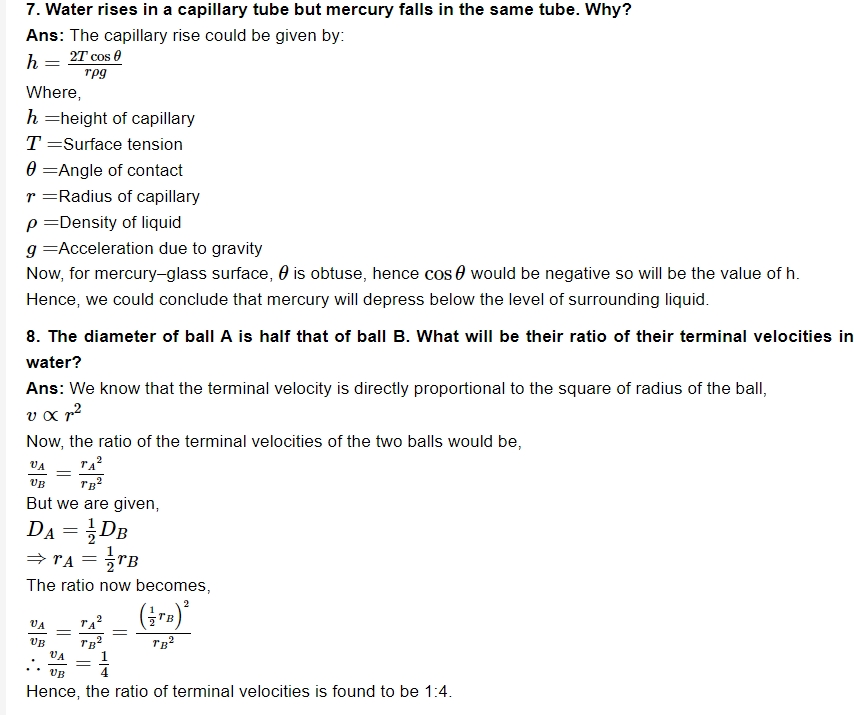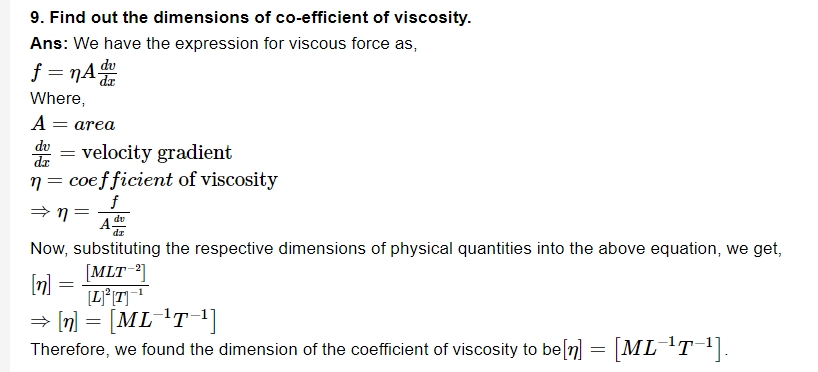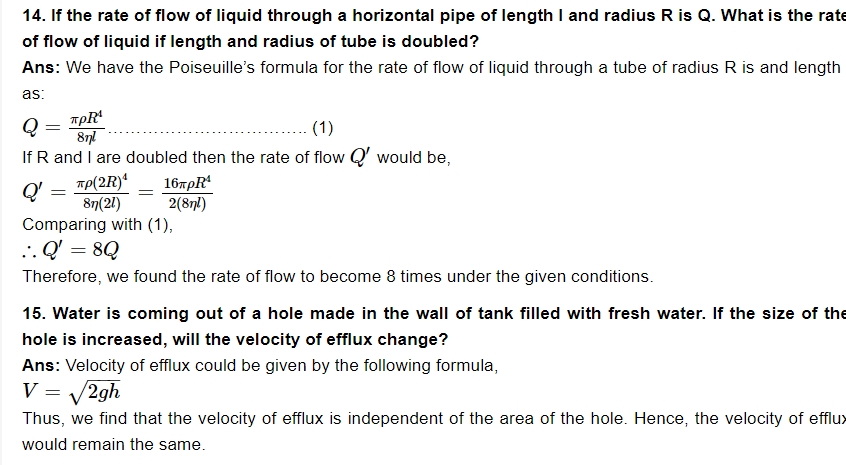
Important Questions for Class 11 Physics Chapter 9: Chapter 9 of Class 11 Physics, Mechanical Properties of Fluids , deals with the study of fluids (liquids and gases) and their behavior under various conditions. Key concepts include pressure, buoyancy, surface tension, viscosity, and the flow of fluids.
Important topics covered are the derivation of pressure in fluids, Archimedes' Principle, Bernoulli's Equation, and the laws of motion for fluids. The chapter also explores different methods of measuring fluid flow, like the Poiseuille's Law for viscosity. Understanding these concepts helps in analyzing real-world phenomena like fluid dynamics in pipes, atmospheric pressure, and the behavior of liquids under different forces.Important Questions for Class 11 Physics Chapter 9 Overview
Class 11 Physics Chapter 9 on Mechanical Properties of Fluids covers essential concepts like pressure, buoyancy, viscosity, and surface tension. Important questions from this chapter help in understanding the behavior of fluids under different conditions, crucial for both theoretical learning and practical applications in engineering and real-life scenarios. These questions test students' grasp of concepts such as Pascal's Law, Archimedes' Principle, and the continuity equation, which are foundational for further studies in fluid mechanics and related fields. Mastering these topics is vital for scoring well in exams and for a deeper understanding of physical systems.Important Questions for Class 11 Physics Chapter 9 PDF
Below, we have provided a PDF containing important questions for Class 11 Physics Chapter 9 Mechanical Properties of Fluids. These questions cover key topics such as buoyancy, surface tension, viscosity, and fluid dynamics. Practicing these questions will help reinforce your understanding of critical concepts, improve your problem-solving skills, and prepare you for exams with a strong grasp of the chapter’s essentials.Important Questions for Class 11 Physics Chapter 9 PDF
Important Questions for Class 11 Physics Chapter 9 With Answers
Below is the Important Questions for Class 11 Physics Chapter 9 Mechanical Properties of Fluids -
1. State the law of floatation .
Ans: Law of floatation states that a body would float in a liquid, if weight of the liquid that is displaced by the immersed part of the body is at least equal to or greater than the weight of the body.
2. Is the blood pressure of humans greater at the feet than at the brain?
Ans: It is clear that the human body's blood column is higher at the feet than it is at the brain. Pressure would be higher at the feet than at the brain because, as we know, pressure is directly correlated with the height of the liquid column.
3. Define surface tension.
Ans: Surface tension is measured as the force that is acting on a unit length of a line that is imagined to be drawn tangentially anywhere on the free surface of the liquid that is at rest.
4. Does Archimedes principle hold in a vessel in a free fall?
Ans: Archimedes Principle will not hold in a vessel in free fall. This is because, in this case, acceleration due to gravity is found to be zero and hence buoyant force will not exist in this case.
5. Oil is sprinkled on sea waves to calm them. Why?
Ans: We are aware that oil-free seawater has a higher surface tension than greasy water. As a result, the sea waves would quiet down because the oil-free water would drive the oily water away from the breeze.
6. A drop of oil placed on the surface of water spreads out, but a drop of water placed on oil contracts. Why?
Ans: The drop of oil spreads out because the cohesive forces between the molecules of oil are known to be weaker than the adhesive forces; this is also true for the drop of water.


10. Define viscosity.
Ans: Viscosity could be defined as the property of a fluid by virtue of which an internal frictional force comes into play when the fluid is in motion and would oppose the relative motion of its different layers.
11.What is the significance of Reynolds’s Number?

12. Give two areas where Bernoulli’s theorem is applied.
Ans: The two well-known areas where Bernoulli’s theorem is applied are: in atomizer and in lifting of an aeroplane wing.
13.What is conserved in Bernoulli’s theorem?
Ans: As per Bernoulli’s theorem, for an incompressible non–viscous liquid (fluid) that is undergoing steady flow the total energy of liquid at all points would be constant.

16. The accumulation of snow on an aeroplane wing may reduce the lift. Explain.
Ans: The accumulation of snow on the airplane's wings would cause the wings' structure to alter and cease to resemble an aerofoil. This would also result in a decrease in the net upward force, or lift.
17. The antiseptics used for cuts and wounds in human flesh have low surface tension. Why?
Ans: When the surface tension of antiseptics is less, they would spread more on cuts and wounds. As a result, the cut or wound is healed quickly.
18. Why should detergents have small angles of contact?

19. Can Bernoulli's equation be used to describe the flow of water through a rapid in a river? Explain.
Ans: No, Bernoulli's equation cannot be used for describing the flow of water through a rapid in a river. This is because, in the mentioned case, the flow of water is turbulent and Bernoulli’s principle can only be applied to a streamline
flow.
20. Does it matter if one uses gauge instead of absolute pressures in applying Bernoulli's equation? Explain.
Ans: No, it doesn’t matter if one uses gauge pressure instead of absolute pressure while applying Bernoulli's equation. But the two points where Bernoulli's equation is applied should have atmospheric pressures that are significantly different.
21. Two vessels have the same base area but different shapes. The first vessel takes twice the volume of water that the second vessel requires to fill up to a particular common height. Is the force exerted by the water on the base of the vessel the same in the two cases? If so, why do the vessels filled with water to that same height give different readings on a weighing scale?
Indeed, the force and pressure acting on the two vessels with the same base area would undoubtedly be the same. The force applied to the sidewalls of the two vessels will have non-zero vertical components since their forms are different. The overall force acting on one vessel would be greater than that acting on the other when these vertical components are included. As a result, these vessels would provide varying readings on a weighing scale when filled with water to the same height.
22. State the angle of contact and on what values the angle of contact depends.
Ans: Angle of contact between a liquid and a solid could be defined as the angle enclosed between the tangents to the liquid surface and the solid surface inside the liquid, both the tangents being drawn at the point of contact of liquid with the solid. Angle of contact is known to depend upon:
-
Upon nature of liquid and solid in contact
-
The Medium which exists above the free surface of liquid.
23. Hydrostatic pressure is a scalar quantity even though pressure is force divided by area, and force is a vector. Explain.
Ans: When force is applied on liquid, the pressure is transmitted equally in all directions inside the liquid. As there is no fixed direction for the pressure here, we could classify it as a scalar quantity.
Benefits of Using Important Questions for Class 11 Physics Chapter 9
Using important questions for Class 11 Physics Chapter 9 Mechanical Properties of Fluids offers several benefits: 1. Concept ReinforcementImportant questions help students focus on key concepts such as buoyancy, surface tension, viscosity, and fluid dynamics. Answering these questions reinforces understanding of the core principles.
2. Better Retention Solving important questions encourages active recall, which helps improve memory retention of critical formulas and laws like Pascal’s law, Archimedes’ principle, and Bernoulli’s equation. 3. Exam Readiness Practicing questions based on the chapter ensures that students are prepared for various exam formats, whether theoretical, numerical, or conceptual, enhancing their ability to tackle different types of problems efficiently. 4. Time Management Important questions often highlight the most frequently tested topics, helping students prioritize their study time effectively and focus on areas with higher chances of appearing in exams. 5. Boosts Confidence Regular practice of essential questions boosts self-confidence as students gain familiarity with the exam pattern and difficulty level, reducing test anxiety.Important Questions for Class 11 Physics Chapter 9 FAQs
What is the most important property in fluid mechanics?
What is the Bernoulli's principle of mechanical properties of fluids?
What are the factors of fluid mechanics?
Are mechanical properties of fluids easy?










